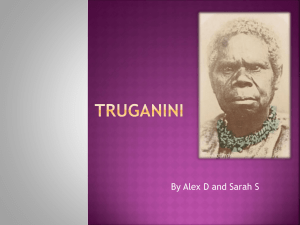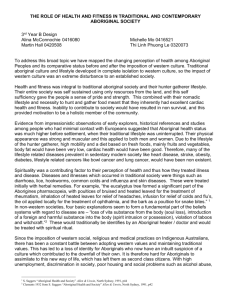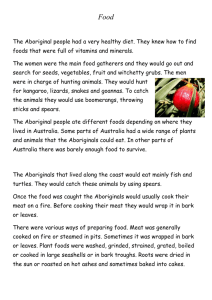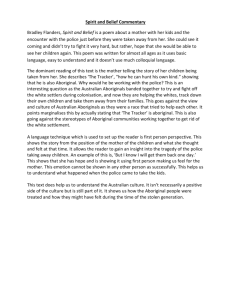Background
advertisement
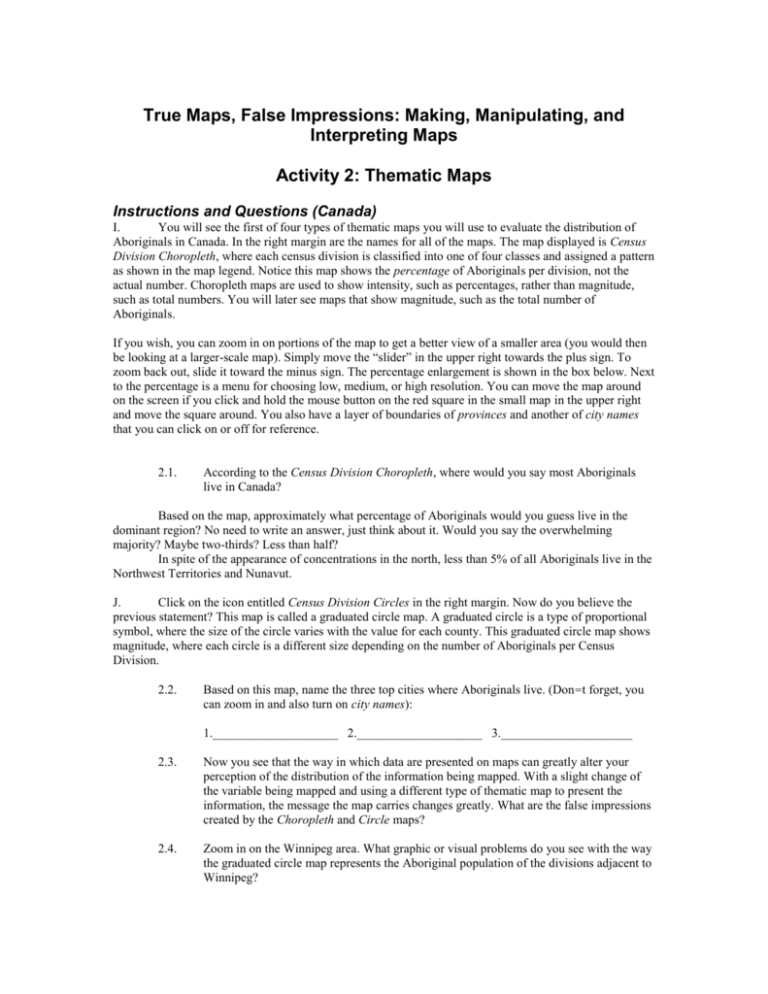
True Maps, False Impressions: Making, Manipulating, and Interpreting Maps Activity 2: Thematic Maps Instructions and Questions (Canada) I. You will see the first of four types of thematic maps you will use to evaluate the distribution of Aboriginals in Canada. In the right margin are the names for all of the maps. The map displayed is Census Division Choropleth, where each census division is classified into one of four classes and assigned a pattern as shown in the map legend. Notice this map shows the percentage of Aboriginals per division, not the actual number. Choropleth maps are used to show intensity, such as percentages, rather than magnitude, such as total numbers. You will later see maps that show magnitude, such as the total number of Aboriginals. If you wish, you can zoom in on portions of the map to get a better view of a smaller area (you would then be looking at a larger-scale map). Simply move the “slider” in the upper right towards the plus sign. To zoom back out, slide it toward the minus sign. The percentage enlargement is shown in the box below. Next to the percentage is a menu for choosing low, medium, or high resolution. You can move the map around on the screen if you click and hold the mouse button on the red square in the small map in the upper right and move the square around. You also have a layer of boundaries of provinces and another of city names that you can click on or off for reference. 2.1. According to the Census Division Choropleth, where would you say most Aboriginals live in Canada? Based on the map, approximately what percentage of Aboriginals would you guess live in the dominant region? No need to write an answer, just think about it. Would you say the overwhelming majority? Maybe two-thirds? Less than half? In spite of the appearance of concentrations in the north, less than 5% of all Aboriginals live in the Northwest Territories and Nunavut. J. Click on the icon entitled Census Division Circles in the right margin. Now do you believe the previous statement? This map is called a graduated circle map. A graduated circle is a type of proportional symbol, where the size of the circle varies with the value for each county. This graduated circle map shows magnitude, where each circle is a different size depending on the number of Aboriginals per Census Division. 2.2. Based on this map, name the three top cities where Aboriginals live. (Don=t forget, you can zoom in and also turn on city names): 1.____________________ 2.____________________ 3._____________________ 2.3. Now you see that the way in which data are presented on maps can greatly alter your perception of the distribution of the information being mapped. With a slight change of the variable being mapped and using a different type of thematic map to present the information, the message the map carries changes greatly. What are the false impressions created by the Choropleth and Circle maps? 2.4. Zoom in on the Winnipeg area. What graphic or visual problems do you see with the way the graduated circle map represents the Aboriginal population of the divisions adjacent to Winnipeg? K. Click on the icon entitled Census Division Dot. Now you see another way to map the distribution of Aboriginals using a dot map. According to the legend, each dot represents 1,000 people. Any division with fewer than 1,000 Aboriginals has no dots, those with 1,000 to 1,999 get one dot, those with 2,000 to 3,999 get two dots, and so on. 2.5. What is the drawback of using this kind of map to compare the number of Aboriginals in different divisions? L. Change the threshold that sets the number of people per dot to 5,000, then to 200, by clicking on the buttons with these resolutions in the right margin. Toggle between the three dot resolutions to see the different impressions they portray. 2.6. Which map emphasizes urban density while minimizing the appearance of the rural North? Why? M. The level of aggregation (i.e., the size of the spatial unit of analysis) is also important to the pattern depicted on the map. Click on Census Division Choropleth map again to get a fresh image of it in your mind, then click on Province Choropleth. This shows the same data, but by province rather than by census division. Note as you move your mouse over each province you see the province name and the percent Aboriginal. 2.7. What different impression of the spatial pattern do you get from the province map compared to the census division map? N. Experiment with the different Color Scheme options seen at the bottom of the window. Think about how the colors relate to the percent Aboriginal. 2.8. Which color scheme, if any, does a poor job of portraying the percent Aboriginal? Why? O. Reinstate the original color scheme. Next you will interactively define your own class limits using the graphic array to the left of the map. This graph shows the distribution of data on the x-axis, in this case percent Aboriginal for each province, from lowest value to highest value. The y-axis, which ranges from 0 to 13 provinces/territories, shows the provinces in rank order from highest to lowest percent Aboriginal. As you move your mouse over the dots in the graph, the province name and percent Aboriginal appears. Starting at the upper left, you can see that the lowest 3 provinces are all 1.3 percent aboriginal or under, the next 3 provinces are between 1.3 percent and 3.0 percent, and so on. Cartographers use graphic arrays to help in setting class breakpoints that divide the data into “natural classes” or groupings. Look for vertical groupings that indicate a group of provinces with similar percentages of Aboriginals, and set your class limits in the empty horizontal gaps. The vertical red bars show your class limits in this distribution. You can select a bar by clicking on the top triangle with your mouse. Holding the mouse button down on the triangle, move it left or right to set new class limits. The shading patterns between the bars match those of the map. The x-axis is labeled in percentages, and when you move the bars, the breakpoints in the boxes below change to reflect the new position. These boxes are also directly editable: click on a breakpoint box, type in a value, and hit return. You will use this interactive graphic array and/or the editable boxes to make you final map. Before then, you next experiment with some other options. P. As you just found out, changing breakpoints between classes can alter the impression the map gives. There are buttons in the lower left that use standard cartographic rules for establishing breakpoints, known as equal frequency and equal interval: Equal frequency Divides the data distribution into classes with equal numbers of provinces in each class (this is the default you first looked at). Click this button and look at the histogram (bar graph) below the map to see the number of provinces in each class. Equal interval Divides the data distribution into classes (intervals) of equal size between the smallest and largest number. Click this button and look at the breakpoints on the graphic array (the red vertical lines) to see that they are equally spaced. The boxes below the graphic array also list the breakpoint values, and they too will be evenly spaced between the minimum and maximum values. The default map uses the equal frequency settings. Click back and forth between the equal frequency and equal interval buttons to see what effect they have on the map. Q. Yet another way to customize a choropleth map is to change the number of classes. The initial map only has 4 classes. You can change the number of classes to 5 or 6 using the small window in the lower-left corner. Set the map to 5 classes and click equal interval then equal frequency. Finally, set 6 classes and click equal interval and equal frequency. From these six distinct maps (Equal Frequency with 4, 5, or 6 classes, and the same for Equal Interval), choose the map you consider to be the most misleading (i.e., it creates the falsest impression of where Aboriginals live). You may wish to consult the actual data values for each state in Table CD.1 to compare actual values to perceived values from the map. R. Using the editable window above the map, change the map title to the “Most Misleading Map.” Go to the File menu and choose Print. Hand in the map with this assignment. 2.9. For your most misleading map, which number of classes did you choose (4, 5, or 6) ______________, and which rule for establishing class breakpoints did you choose (Equal Frequency or Equal Interval)________________________. Why is the map you chose misleading? Table CD.1. 1996 Aboriginal Population Data. Province or Territory Number of Aboriginals Alberta 122,835 British Columbia 139,640 Manitoba 128,670 New Brunswick 10,375 Newfoundland 14,200 Northwest Territories 39,695 Nova Scotia 12,755 Nunavut 21,095 Ontario 141,505 Prince Edward Island 955 Quebec 71,390 Saskatchewan 111,235 Yukon Territory 6175 Percent Aboriginal 4.60 3.78 11.69 1.36 2.60 61.91 1.25 84.09 1.33 0.72 1.01 11.39 20.15 S. Finally, using the interactive graphics array and thinking about the various options you have already seen, set the number of classes and the breakpoints to what you think is “best.” Print and hand in this map, clearly labeled “Best Map.” 2.10 Why did you select these as the best classes? T. Click on Census Division Isoline. Isolines are lines that connect points of equal value, in this case, equal percentages of Aboriginals. Therefore, as you cross an isoline, you are going into an area with either higher or lower percentage Aboriginal. Interpretation of the spacing and configuration allows one to “read” a third dimension portrayed on the map, an Aboriginal “surface” with peaks of high percentage and valleys of low percentage (see Figure 1.12 in the book). The legend says the isoline interval is 20%. Therefore, the map has isolines at 0%, 20%, 40%, 60%, 80%, and 100%. Try to picture the surface which the map represents. Starting from the lowest zone in east-central British Columbia, move east towards the Hudson Bay. You pass through the highest “peak” in northern Saskatchewan, then dip back down into the bay. 2.11. Where in the country do you see the most rapid change (greatest change in percent Aboriginal over the shortest distance)? 2.12. Look at the range within which most of Newfoundland falls. Based on this, what would be a good guess for the average percent Aboriginal in Newfoundland? 2.13. Does the isoline surface accurately depict where Aboriginals are concentrated? Look at the province and census division choropleth maps to get a feel for the concentration of Aboriginals, then compare your isoline “peaks” and “valleys” to see if this concentration is accurately shown. Point out some noticeable similarities or dissimilarities between the two maps. 2.14. Think about TV shows and movies you have seen that prominently feature Aboriginals. List the locations or types of places where these media images take place. 2.15. Based on the maps you have seen of the distribution of Aboriginals, does the entertainment industry accurately represent where Aboriginals live? What stereotypes are embodied in these media images? So, now your eyes are open to how maps can mislead you. You might be wondering how common it is for different thematic maps of the same data to give such different impressions. You may wish to take a quick look at the maps of African Americans in the United States on this CD. Click on the hyperlink Activity 2: Thematic Maps (USA) below. At the end of that section are also maps of four other ethnic and racial groups in the United States. Go to Step V in the book to see more ethnic groups in the United States. U. When you are finished, close the Activity 2: Thematic Maps browser window, and click the exit button at the top right of the Chapter Contents page. If you are on a campus network, log off your machine. Don’t forget your CD.




